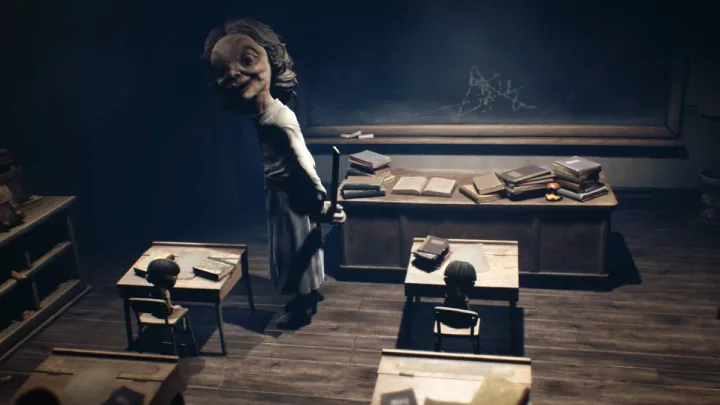Little Nightmares II is a masterclass in atmospheric horror and environmental puzzle-solving, but beneath its stunning visuals and tense encounters lies a game that demands precision, observation, and a mastery of its unique mechanics. For those who have braved the Pale City and wish to go beyond simple survival, this guide offers insights into advanced strategies and techniques that will elevate your gameplay from mere completion to true mastery.

The Art of Stealth and Evasion
Little Nightmares II is fundamentally a game of hide-and-seek. The most common mistake is to rush headlong into danger, but a seasoned player understands that patience is a more valuable weapon than any object you might find.
- Anticipate the Predator's Path: Enemies in Little Nightmares II, such as the Teacher or the Hunter, often follow predictable patrol routes. Instead of reacting to their movements, anticipate them. Observe their patterns from a safe distance and only move when you are certain of an open window. This is especially true in sections like the school, where the Teacher's head-turning is a visual cue for her patrol.
- Use the Environment to Your Advantage: The world of Little Nightmares II is filled with hiding spots, from cardboard boxes and hospital beds to the shadows themselves. However, a novice might only see the obvious. An expert player knows that almost any object can be used to break line of sight. For example, in the hospital, you can use the gurneys and operating tables to obscure your movement from the Mannequins.
- Master the Stumble: The "stumble" mechanic, where you momentarily lose your balance after a short sprint, is not a bug—it’s a feature. An advanced player uses this mechanic to their advantage, timing their sprint to an obstacle to deliberately stumble and hide. This is particularly effective against the Doctor, as you can use the stumble to quickly duck under a gurney and out of his sight.
Combat and Object Manipulation
While combat is rare in Little Nightmares II, when it does occur, it's brutal and unforgiving. Mastering the use of weapons is crucial.
- Timing is Everything: Swinging a hammer or an axe is a slow, telegraphed action. You must time your swing precisely. An expert player doesn't just react to the enemy; they predict their movement and begin the swing early. Against the Bullies, for instance, you should start swinging your weapon as they begin their charge, not as they arrive.
- The Weight of the Weapon: The size and weight of a weapon affects its swing arc and speed. A hammer is slow and cumbersome but has a wide, sweeping arc. An axe is faster but has a narrower attack path. Choose your weapon based on the enemy type and the environment. In tight corridors, the axe is more effective, while in open rooms with multiple enemies, the hammer’s wider arc is better for crowd control.
- Utilize Mono's Unique Ability: Mono’s television-related abilities are not just for puzzles. The distortion they cause can be used to momentarily disorient enemies, giving you a chance to escape or even set up an attack. In the Doctor’s workshop, using a television to lure him away from a path is a more sophisticated approach than simply trying to run past him.

Puzzle-Solving and Environmental Awareness
The puzzles in Little Nightmares II are often more about observation than logic. The answers are usually hidden in plain sight.
- Pay Attention to Auditory Cues: Sounds are as important as visuals. The clanking of the Hunter’s boots, the creaking of the Teacher’s neck, the static from a nearby television—all of these are not just for atmosphere; they are critical cues. A good player listens for these sounds to determine an enemy's location or to identify a hidden puzzle element.
- Think Like the Game Designers: The game’s puzzles are designed to force you to interact with the environment. If you see an object that looks out of place—a key hanging on a wall, a toy in an unusual spot—it’s probably a puzzle piece. For example, in the school, the chess pieces and their arrangements are not just decoration; they are the key to a puzzle.
- Utilize Six as an Asset, Not a Hindrance: Six is not a sidekick; she is an essential part of your toolkit. You can use her to reach high places, solve tandem puzzles, and even distract enemies. An advanced player understands her limitations and strengths, knowing when to give her a boost or to lure an enemy toward her so you can make your escape.
The Final Showdown: The Thin Man and the Signal Tower
The final chapters of the game require all of these skills to be combined.
- Mastering the Thin Man: The encounters with the Thin Man are a test of your spatial awareness and timing. You must learn the rhythm of his attacks, which are often telegraphed by a low hum or a change in the environment. An advanced strategy is to use the environment to your advantage, ducking behind obstacles and only moving when he is charging up his next attack.
- The Signal Tower's Challenges: The Signal Tower is a series of environmental challenges that require fast thinking and precise platforming. Don’t rush. Observe the patterns of the corrupted residents and use the flickering light and distortion to your advantage. Remember that many of the platforming sections are more about timing than about raw speed.
Conclusion
Little Nightmares II is a game that rewards observation, patience, and strategic thinking. By moving beyond a simple trial-and-error approach and instead focusing on anticipating threats, mastering the unique combat mechanics, and meticulously observing the environment, you can turn a terrifying escape into a strategic masterpiece. The world of the Pale City is cruel, but with these advanced techniques, you can become the predator, not the prey.

















